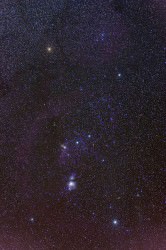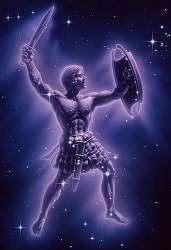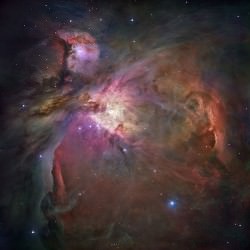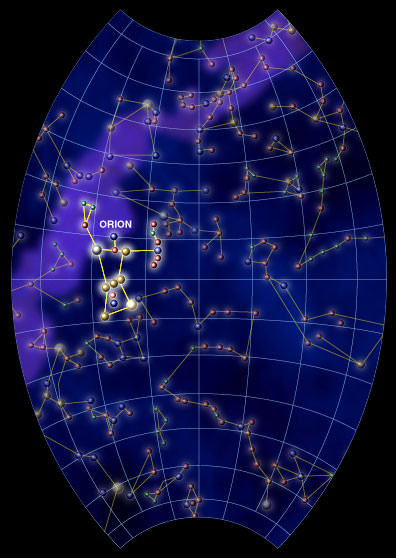If you’ve been peeking out the windows at night, or maybe looked up while walking the dog before bedtime or taking out the trash after dinner, perhaps you’ve seen three fairly bright stars in a row. Depending on how early or late you look, you may see them lined up side-by-side above the horizon, or they may be one on top the other when they are setting to the west. If you’ve noticed them, you wouldn’t be the first… Humankind has been telling stories about this set of stars for centuries!
 The three stars are the most notable feature in the ancient constellation of Orion and it’s best to look for them just after the Sun sets and the skies get dark. If you live in the northern half of the world, you’ll find them to the south. If you llive near the equator, they will be overhead. If you live in the southern hemisphere, you’ll spy the trio north. But no matter where you live, the Star Hunter is visible to everyone! Once you see it, hold your left hand out at arm’s length and spread your fingers wide – covering the three stars with your palm. If you look just above your little finger, you will see an orange looking star. It’s name is Betelgeuse and it’s the brightest of all the stars in the constellation. Just below your thumb you’ll see another bright star. This blue/white giant is named Rigel and it’s the second brightest star. Now, take your hand away and look at the pattern. Do you see a connect-the-dots hourglass shape? Congratulations! If your skies are dark enough, you’ll see a patch of stars to the north that represents the head of the hunter. To the west you may see a curved line of stars that represents his bow or shield. But the most special place of all is just below those three stars…
The three stars are the most notable feature in the ancient constellation of Orion and it’s best to look for them just after the Sun sets and the skies get dark. If you live in the northern half of the world, you’ll find them to the south. If you llive near the equator, they will be overhead. If you live in the southern hemisphere, you’ll spy the trio north. But no matter where you live, the Star Hunter is visible to everyone! Once you see it, hold your left hand out at arm’s length and spread your fingers wide – covering the three stars with your palm. If you look just above your little finger, you will see an orange looking star. It’s name is Betelgeuse and it’s the brightest of all the stars in the constellation. Just below your thumb you’ll see another bright star. This blue/white giant is named Rigel and it’s the second brightest star. Now, take your hand away and look at the pattern. Do you see a connect-the-dots hourglass shape? Congratulations! If your skies are dark enough, you’ll see a patch of stars to the north that represents the head of the hunter. To the west you may see a curved line of stars that represents his bow or shield. But the most special place of all is just below those three stars…
 The ancient Greeks gave us a lot of great stories – many of them very different from each other. One might say that Orion was a great hunter who was banished to the sky for bragging on how many animals he could kill and the two bright stars which follow him represent his hunting dogs. Another says Orion fell in love with a goddess and was killed by an arrow when the goddess’ brother was tricked into shooting him. Still another says he was killed by a sting from Scorpio, the Scorpion. No matter which tale you may care to listen to, the fact remains that cultures all over the world have recognized this constellation for centuries on end and all see Orion as a human figure. But why would they notice this constellation more than any other? Maybe it’s the magic that’s just below those three stars!
The ancient Greeks gave us a lot of great stories – many of them very different from each other. One might say that Orion was a great hunter who was banished to the sky for bragging on how many animals he could kill and the two bright stars which follow him represent his hunting dogs. Another says Orion fell in love with a goddess and was killed by an arrow when the goddess’ brother was tricked into shooting him. Still another says he was killed by a sting from Scorpio, the Scorpion. No matter which tale you may care to listen to, the fact remains that cultures all over the world have recognized this constellation for centuries on end and all see Orion as a human figure. But why would they notice this constellation more than any other? Maybe it’s the magic that’s just below those three stars!
 If you live where the skies are dark, you’ll see another line of stars just below the trio. In myth, this represents Orion’s “sword”, but it’s a magic one. Take a close look and you’ll see a ghostly glow just about in the center of the sword. If you don’t spot it with your eyes alone, try using a pair of binoculars. It will look like a glowing cloud for a very good reason. It’s a cloud where stars are being born! This glowing gas cloud is called the Great Orion Nebula and the light you see now left on its journey to your eyes around 500 A.D. That’s about the time that King Arthur was around! Inside are hundreds of stars being born and their energy lights up the gas, just like a neon tube. While you won’t see the pretty colors with your eyes the way the camera does, you can still enjoy the magic and share what you’ve learned with your friends. All you need to do is just find three stars in a row…
If you live where the skies are dark, you’ll see another line of stars just below the trio. In myth, this represents Orion’s “sword”, but it’s a magic one. Take a close look and you’ll see a ghostly glow just about in the center of the sword. If you don’t spot it with your eyes alone, try using a pair of binoculars. It will look like a glowing cloud for a very good reason. It’s a cloud where stars are being born! This glowing gas cloud is called the Great Orion Nebula and the light you see now left on its journey to your eyes around 500 A.D. That’s about the time that King Arthur was around! Inside are hundreds of stars being born and their energy lights up the gas, just like a neon tube. While you won’t see the pretty colors with your eyes the way the camera does, you can still enjoy the magic and share what you’ve learned with your friends. All you need to do is just find three stars in a row…
Image Credits: Orion Chart courtesy of University Corporation for Atmospheric Research (UCAR), Orion Sky Shot courtesy of Mouser Williams, Stellarium represenation of Orion and Orion Nebula courtesy of the Hubble Space Telescope.


Amazing illustration for kids, and to myself too haha! Orion is exactly lay on my head every night but most of my surrounding friends don’t know what to call it. It will be more perfect if each of the single star make up the Orion is named here (we’re studying molecular science and knew little about cosmology) =_=
Sorry, i mean the name of stars nearby Orion =)
Cheers!
Good read. May I suggest adding how to find Aldebaran and SIrius in relation to Orion? They are really close.
Calling all potential molecular scientists.
Take a look at the RHS of the page where this post appears, see “most popular articles”.
Top of all is “list of constellations”, another of Tammy’s super contributions to popular astronomy.
Click on Orion for a good deal more about that constellation, also in the Orion grouping are Tarus, Canis major and Canis minor.
Hope that helps.
Brian
Roseland Observatory.
Thank you Brian for your kind assist in directing me to the links, this should enable me to learn more about the cluster of stars surrounding my head. Cheers! =)
thanks, brian!
hmmmm…. methinks it might be a good idea to do some of the other nearby constellations for kids (and kids at heart) as well!
you good folks out there are truly what keep me going…
:*)